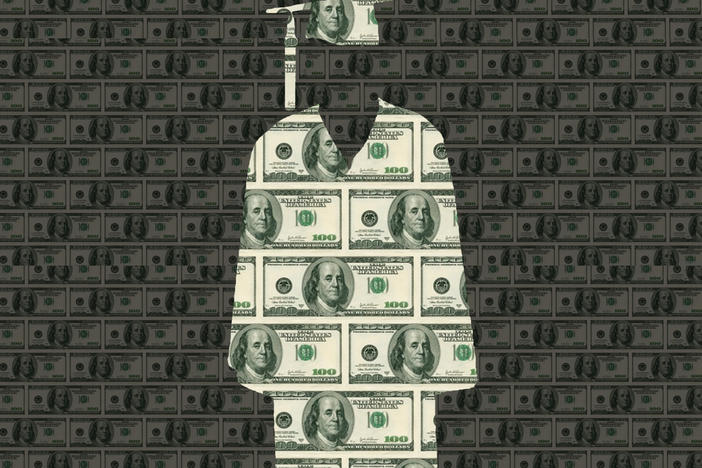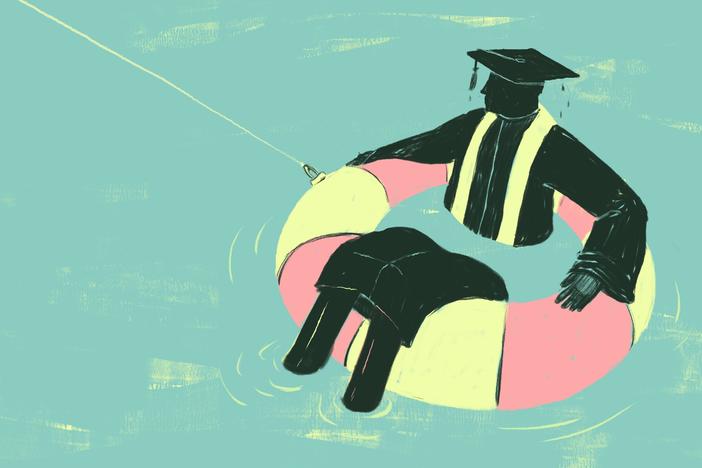Section Branding
Header Content
Borrowers who were cut out of student loan relief describe 'a gut punch'
Primary Content
Updated October 19, 2022 at 11:20 AM ET
Listen closely. Between the din of supporters cheering the cancellation of some federal student loan debts, and the clamor of conservative lawyers arguing that President Biden's debt relief plan is wildly unconstitutional, you can hear the frustration of borrowers trapped in the middle.
"Emotionally, it's like a gut punch," says Chris Tasich.
Lisa Thackwell uses the same language: "A punch to the gut. It would have cut my debt in half," Thackwell says of Biden's August promise to erase $10,000 of her loan debt. She and her husband had planned to put the savings toward their boys' education.
But that was before the U.S. Department of Education quietly reversed itself last month, and suddenly excluded hundreds of thousands of student loan borrowers, including Tasich and Thackwell, from Biden's debt relief plan – borrowers it had told, just weeks earlier, could qualify.
FFEL loans are federal loans, managed by private banks
Tasich and Thackwell have an old kind of student loan, known as a Federal Family Education Loan or FFEL. Once the foundation of the federal student loan program, FFELs were issued and managed by private banks or state-based lenders, but guaranteed by the U.S. government.
Today, most federal student loans are Direct Loans, but before 2010 Direct Loans were a sideshow to the FFEL program's main attraction.
"We should always keep in mind that FFEL loans are federal loans, period," says Dominique Baker, a professor of education policy at Southern Methodist University.
The Obama administration shuttered the FFEL program in 2010 in an effort to save money.
Thus began the ascendancy of federal Direct Loans. But more than a decade after the FFEL program ended, more than 4 million borrowers still have these old loans, held by banks and outside lenders. And Baker says these are precisely the borrowers Biden's plan was meant to help, with its promise of providing "more breathing room to America's working families".
"[FFEL] borrowers were more likely to attend community colleges, for-profits and HBCUs. And this is fairly old debt," Baker says. Characteristics that often also describe low-income borrowers.
That's why, in August, President Biden told FFEL borrowers they could qualify for debt relief. All they needed to do, according to the Education Department website, was consolidate their old loans into new, Direct Loans. Those new loans would then qualify them for relief.
That guidance would change dramatically just a month later.
The lawsuit that dashed the hopes of many FFEL borrowers
When Biden first announced his loan relief program, Jennifer Newell Davies started making plans.
"I was really counting on having that lower monthly payment to contribute to my mortgage," says Davies, who has just under $6,000 in outstanding FFEL loans.
Then, in late September, several Republican state attorneys general sued Biden and the Education Department, arguing that erasing these old FFEL loans would cause serious financial harm to the banks and outside lenders who still manage and profit from them – and calling on the courts to stop debt relief for all. The day that suit was filed, Sept. 29, the department quietly changed its rules to exclude FFEL borrowers who had not yet applied to consolidate their loans.
Davies says she was waiting to consolidate until the department officially released its debt relief application (which happened on Monday). "All the messaging I got was to wait, and we were told to wait, wait, wait. And then all of a sudden, the rug pulled out from beneath us."
"Honestly, I cried a bit when I found out it might not be forgiven," she says. "And that's when I started the petition."
Davies is gathering signatures from fellow borrowers to make clear this reversal will hurt a lot of people. But she worries no one will care.
"Republicans aren't stepping out there to help," Davies says, pointing out that it's Republicans filing these legal challenges, "but now it feels like Democrats are turning their backs."
It feels that way because the Education Department reversed itself without a formal announcement, explanation or acknowledgment of the whiplash borrowers were experiencing.
In fact, some FFEL borrowers told NPR they weren't expecting debt relief when Biden announced his plan in August. Their frustration now – and anger – is over the reversal itself: Being told they qualify, then five weeks later being told they don't, without any explanation.
At the time, all the department offered was this statement to NPR:
"Our goal is to provide relief to as many eligible borrowers as quickly and easily as possible, and this will allow us to achieve that goal while we continue to explore additional legally-available options to provide relief to borrowers with privately owned FFEL loans and Perkins loans, including whether FFEL borrowers could receive one-time debt relief without needing to consolidate... The FFEL program is now defunct and only a small percentage of borrowers have FFEL loans."
The change affects almost 800,000 borrowers
That last line, about FFEL borrowers being a "small percentage," became the sum of the Biden administration's strategy: to downplay the reversal by minimizing the number of borrowers affected.
White House press secretary Karine Jean-Pierre told reporters, "the number of borrowers impacted in this change is much smaller. I know there [were reports of] a number of millions, but it's actually much smaller."
Compared to the more than 40 million borrowers who could potentially qualify for debt relief, Jean-Pierre is right. The excluded FFEL borrowers account for just 2% of the whole.
But that's still just under 800,000 borrowers, according to the White House – enough disillusioned people to fill Yankee Stadium at least 14times.
"It makes me so angry. They just continue to say that, 'It's a small group. It's a small group. It's a small group,' " says FFEL borrower Chris Tasich. "But it's a vulnerable group. They've held debt longer than most. And they've consistently been marginalized."
"I'm really upset that there are those of us who have been paying for 20 years, and we're considered a small enough number that we can be disposed of," says FFEL borrower Amy Rush. "I don't know if other people are as disillusioned as I am, but, you know, I'm hoping we can fight back."
FFEL borrowers have repeatedly been excluded from benefits enjoyed by Direct Loan borrowers, even though the only real difference between them is when they took out their federal loans.
For example, some of the controversy around borrowers failing to qualify for Public Service Loan Forgiveness (PSLF) stemmed from the kind of loans they had. Direct Loans qualified; FFELs didn't, even though they were the workhorse of the federal student loan program when PSLF was created.
More recently, FFEL borrowers with loans still held by outside lenders couldn't qualify for the pandemic pause in interest and repayment, either, without switching to Direct Loans.
"Really through the last several decades, [FFEL borrowers] are always the borrowers thrown under the bus," says Persis Yu, deputy executive director of the Student Borrower Protection Center. "They were excluded from the CARES Act. They were excluded from PSLF. They've been excluded from the more generous [income-driven repayment plans]. It really is tragic how FFEL borrowers have been treated as if they're expendable."
One FFEL borrower files a lawsuit
Recent court documents offer the clearest explanation yet for why the Biden administration suddenly excluded FFEL borrowers from debt relief.
On Oct. 7, the Justice Department cited the FFEL rule change in its rebuttal to that lawsuit from several Republican state attorneys general, arguing that, since the department excluded FFEL borrowers from its debt relief plan, these FFEL lenders can no longer demonstrate harm.
Translation: The White House cut these borrowers out to legally protect debt relief for everyone else.
To the 98% of borrowers who still qualify, that may seem a worthy sacrifice.
To the 2% left behind, it's cold comfort.
What's more, while excluding FFEL borrowers may help the department deflect one lawsuit (the judge has yet to weigh in), it may have a different effect in another.
On Oct. 10, the conservative Job Creators Network Foundation's Legal Action Fund filed a lawsuit on behalf of two plaintiffs, one of whom, Myra Brown, is herself a FFEL borrower who does not qualify for debt relief.
"If the Department is going to provide debt forgiveness, Ms. Brown believes that her student loan debt should be forgiven too," the complaint says. "She believes it is irrational, arbitrary, and unfair to exclude her."
As a result, the plaintiffs argue, a judge should stop debt cancellation for all borrowers.
Copyright 2022 NPR. To see more, visit https://www.npr.org.
Bottom Content




